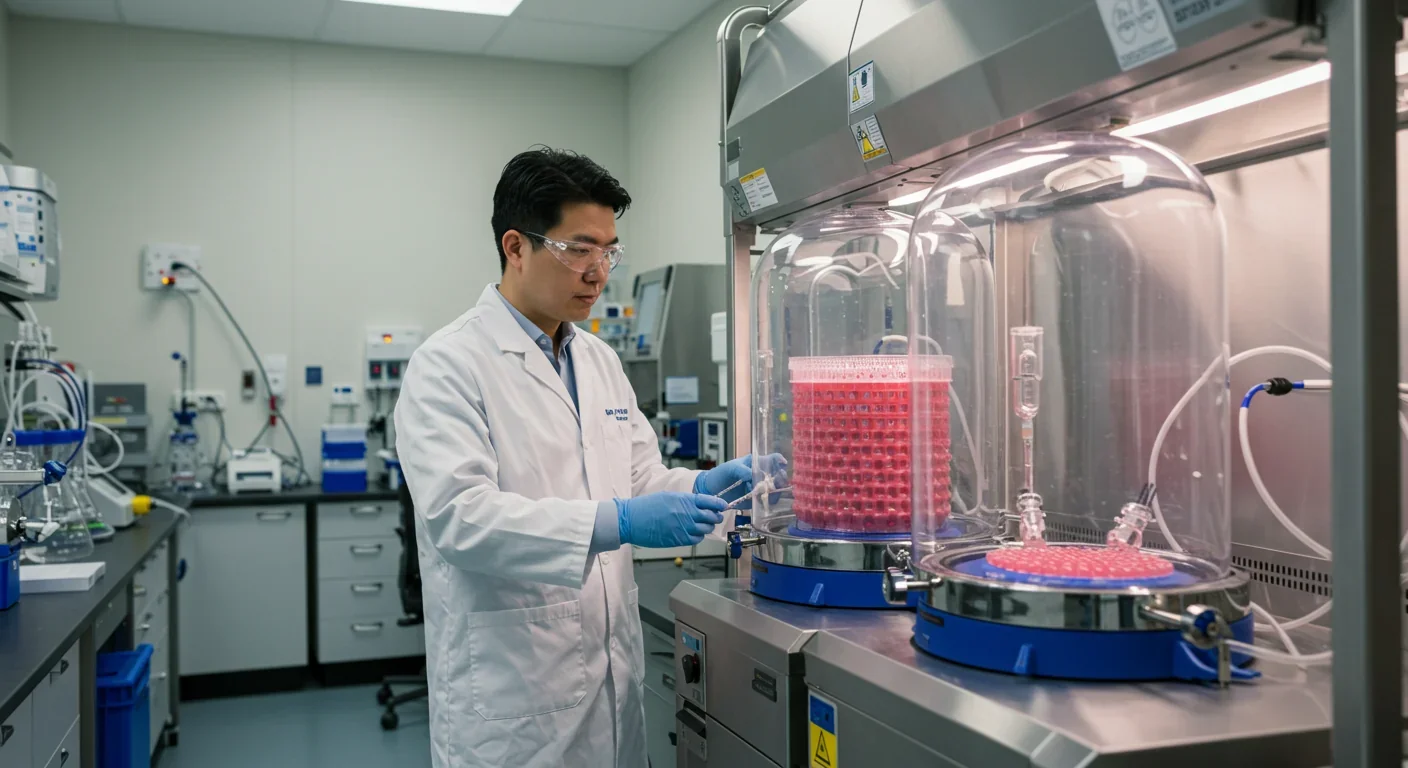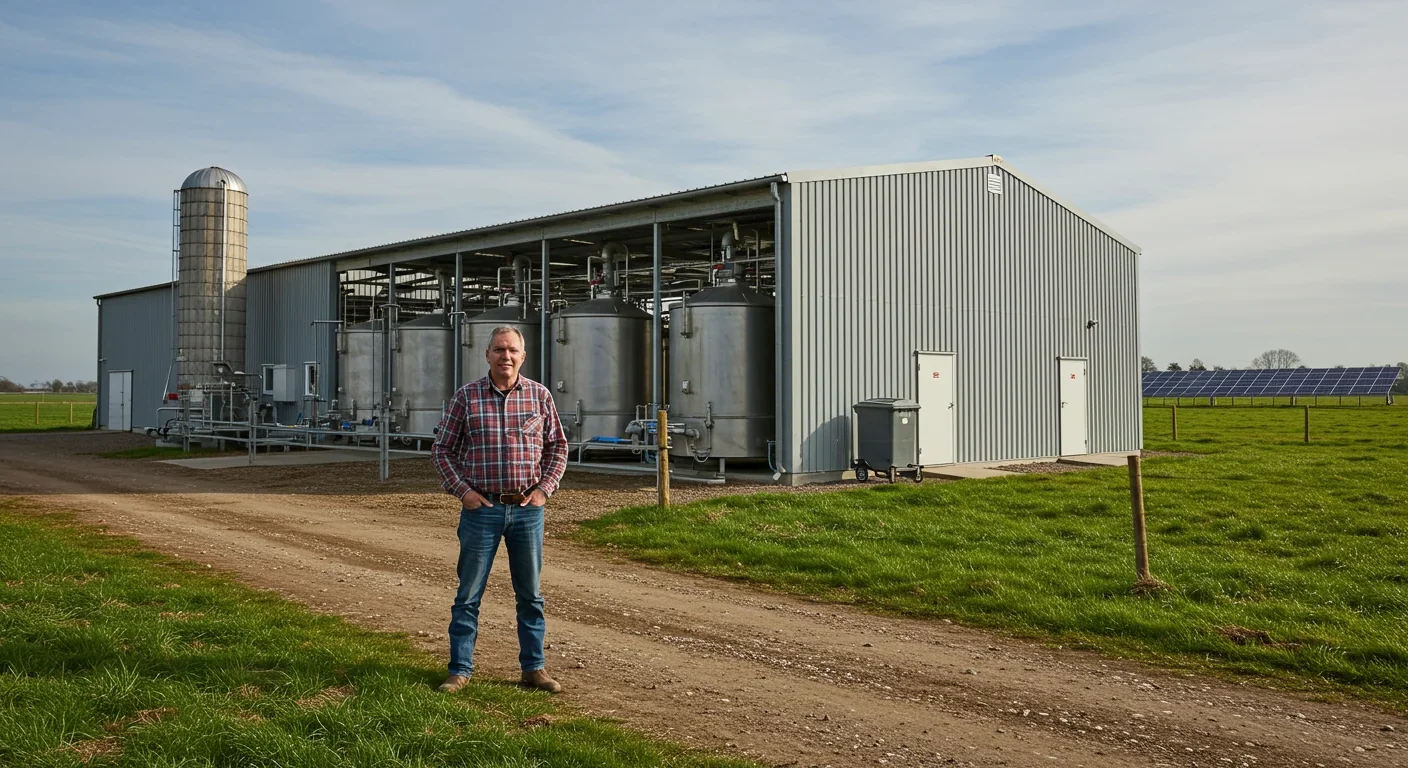Digital Pollution Tax: Can It Save Data Centers?

TL;DR: Lab-grown meat could slash agriculture's environmental footprint by 90%, but scaling from a $335,000 burger to affordable supermarket reality faces engineering hurdles, regulatory battles, and consumer psychology. The next decade will determine whether bioreactors replace pastures.

Within the next decade, the steak on your plate might come from a bioreactor instead of a pasture. Scientists have cracked the code on growing real meat from cells, bypassing the animal entirely. The environmental promise is staggering: dramatically lower greenhouse gas emissions, a fraction of the land and water use, and none of the antibiotics or hormones. But cultured meat faces challenges that could make or break its future. Can this technology deliver on its sustainability promise, or will regulatory battles and consumer skepticism keep it confined to high-end restaurants?
Cultured meat isn't a meat substitute made from plants. It's actual animal tissue, grown in a lab from a tiny sample of cells harvested from living animals. The process starts with stem cells, typically satellite cells from muscle tissue, that have the natural ability to multiply and differentiate. Scientists place these cells in a nutrient-rich culture medium inside a bioreactor, where they proliferate just as they would inside an animal's body.
The first cultured burger, unveiled in 2013, cost over $335,000 to produce. That astronomical price tag reflected the complexity of replicating what evolution perfected over millions of years. Growing muscle tissue requires precise control of temperature, pH levels, oxygen, and nutrient delivery. The cells need growth factors and proteins to signal when to divide and when to mature into muscle fibers.
Recent breakthroughs have slashed costs dramatically. Bioreactor equipment that once cost £250,000 now runs about £15,000 for similar capacity. Culture media, the liquid that feeds growing cells, has seen cost reductions of up to 90% through innovations in formulation and sourcing. Companies like BiOM Farms are developing immortalized cell lines that can reproduce indefinitely without degrading, eliminating the need for repeated animal biopsies.
Humanity's relationship with meat production has always been about efficiency gains. Domestication let us stop chasing wild game. Selective breeding created animals that grew faster and larger. Industrial agriculture packed more animals into smaller spaces, driving down costs but creating new problems: concentrated waste, disease outbreaks, antibiotic resistance, and greenhouse gas emissions that rival the transportation sector.
Each wave of innovation promised to feed more people at lower cost, and each delivered, at least initially. But the environmental bill has come due. Livestock production uses 77% of global agricultural land while providing only 18% of global calorie supply. Cattle burp methane, a greenhouse gas 28 times more potent than carbon dioxide over a century. Manure lagoons leak nitrogen and phosphorus into watersheds, triggering algae blooms that suffocate aquatic life.
The search for alternatives has produced plant-based burgers that bleed and sizzle convincingly. But cellular agriculture represents something fundamentally different: not imitation, but biological production decoupled from the animal. The technology builds on decades of tissue engineering developed for medical applications, where scientists learned to grow skin grafts, cartilage, and even beating heart tissue in labs.
Mark Post, the Dutch researcher who created that first $335,000 burger, saw cultured meat as the logical next step. If we could grow replacement organs, why not food? The question wasn't whether it was possible, but whether it could scale economically and whether people would actually eat it.
Scaling from a single burger patty to feeding millions requires solving problems that don't exist in traditional agriculture. Animals are self-regulating bioreactors: they maintain their own temperature, circulate nutrients through blood vessels, and eliminate waste products. Replicate those functions in steel tanks, and you need sophisticated bioprocess engineering.
Current bioreactors can grow beyond 50 liters of cell culture, but industrial meat production will need vessels measured in thousands of liters. Keeping cells alive and growing uniformly at that scale means solving fluid dynamics, heat transfer, and mass transport challenges. Cells at the center of a large bioreactor can suffocate without adequate oxygen circulation. Too much agitation, and physical shear forces damage delicate cell membranes.
The culture medium presents another hurdle. Conventional cell culture relies on fetal bovine serum, extracted from unborn calves during slaughter. Obviously, that defeats the entire purpose of cultured meat. Companies are racing to develop animal-free growth factors using precision fermentation, where microorganisms are genetically programmed to produce the exact proteins cells need. Iceland's ORF Genetics just secured $5.8 million to scale production of growth factors grown in barley plants.
Texture is harder than it sounds. Ground meat for burgers or nuggets is relatively straightforward, you just let cells multiply into a slurry and form it into shape. But a ribeye steak has fat marbling, connective tissue, and muscle fibers aligned in specific directions that determine tenderness and flavor. South Korean researchers achieved a breakthrough by growing beef cells inside rice grains treated with enzymes, creating a hybrid that could eventually mimic marbled meat.

The environmental case for cultured meat looks compelling on paper. Studies project reductions of 92% in greenhouse gas emissions, 95% in land use, and 78% in water consumption compared to conventional beef production. Those numbers assume cultured meat production runs on renewable energy, which isn't yet standard but is technically feasible.
The land savings alone could reshape global ecosystems. Livestock grazing and feed crop production currently occupy an area larger than North and South America combined. Freeing even a fraction of that land could allow massive reforestation, restoring carbon sinks and biodiversity. Regions devastated by deforestation for cattle ranching, from the Amazon to Southeast Asia, could begin to recover.
Water use matters especially in regions facing scarcity. A single kilogram of beef requires roughly 15,000 liters of water when you account for growing feed crops. Cultured meat facilities would use a fraction of that, and the water could be recycled within a closed system. No manure runoff, no methane emissions, no antibiotics breeding resistant bacteria in the water supply.
Energy requirements tell a more nuanced story. Bioreactors need heating, cooling, and sterilization. Culture media production requires fermentation facilities. The carbon intensity depends entirely on the energy source. Powered by coal, cultured meat could actually produce more emissions than chicken or pork. Powered by solar or wind, it could be the cleanest protein source humans have ever developed.
Cost parity is the make-or-break metric. Industry projections suggest cultured meat could match conventional meat prices within seven to ten years, according to Zak Weston of the New Harvest Foundation. That timeline depends on continued innovation in cell line development, media formulation, and bioreactor design.
The learning curve is accelerating. When semiconductors followed Moore's Law, doubling in performance every two years, it transformed entire industries. Cultured meat isn't on quite that trajectory, but costs are dropping exponentially as production scales and processes optimize. Sweden's Remeat is building Scandinavia's first commercial facility, targeting production capacity that would have been unthinkable five years ago.
Venture capital has poured billions into the sector, betting that whoever achieves cost parity first will capture massive market share. But the funding environment has cooled as investors realize the timeline to profitability is longer than initially hyped. Companies that survive will need either deep pockets or niche markets willing to pay premium prices during the scale-up phase.
Vow, an Australian cultured meat company, has placed its cultured quail on about 20 restaurant menus in under a year since gaining regulatory approval. The strategy is to build demand among early adopters willing to pay more for novelty and sustainability, then scale down to mass market pricing. It's the same playbook that worked for electric vehicles, flat-screen TVs, and solar panels.
Consumer acceptance varies wildly by region and demographic. Surveys show India displays higher trust in emerging food technologies compared to skeptical European markets like Croatia. Younger consumers are generally more willing to try cultured meat, especially those concerned about climate change and animal welfare.
Taste tests reveal that when people can't see what they're eating, they often can't tell the difference between cultured and conventional meat. The psychological barrier is knowing it came from a lab instead of a farm. Focus groups in Italy revealed that participants valued transparency about production methods and needed clear labeling to build trust.
The "ick factor" is real but not insurmountable. People once found the idea of drinking pasteurized milk strange, viewing it as "cooked" and unnatural. Sushi seemed exotic and off-putting to American consumers before becoming mainstream. Cultured meat faces a steeper hill because it challenges cultural traditions around farming, cooking, and the relationship between humans and animals.
Marketing will be crucial. Early messaging that emphasized "lab-grown" and "Frankenstein meat" triggered disgust reactions. Reframing it as "cultivated" or "cell-based" meat, emphasizing that it's real animal tissue grown more efficiently, tests better. Highlighting the environmental benefits resonates with climate-conscious consumers, while the animal welfare angle appeals to those troubled by factory farming conditions.

Getting cultured meat approved for sale is a marathon of safety testing, documentation, and political navigation. Singapore led the way in 2020, approving cultured chicken from Eat Just after reviewing production processes, nutrient composition, and potential allergens. The city-state's strategic focus on food security, given its limited agricultural land, made it an ideal first mover.
The United States followed in 2023, with the FDA and USDA jointly approving products from Upside Foods and Good Meat. The regulatory framework treats cultured meat as both a food additive under FDA jurisdiction and a meat product under USDA oversight. This dual authority creates complexity but also thoroughness in safety evaluation.
Europe's regulators are moving more slowly, requiring extensive documentation under novel food regulations. But the EU just backed a project to build the world's first cultivated meat farm in the Netherlands, financed partly by a €2 million grant from the EIT Food accelerator. That signals at least some official support for the industry, even if commercial approval remains distant.
Backlash has been fierce in some jurisdictions. Texas banned production and sale of cultured meat from September 2025 through September 2027, with fines up to $25,000 per day for violations. Senate Bill 261 passed despite opposition from environmental groups and tech advocates, driven by livestock industry lobbying and cultural identity politics around cattle ranching.
Similar bans have spread across conservative states, framing cultured meat as an attack on traditional agriculture and rural livelihoods. The Trump administration's first unified regulatory agenda proposed eliminating the private self-affirmation pathway for GRAS (Generally Recognized As Safe) ingredients, requiring mandatory FDA filing for all novel food ingredients. That could slow innovation but might also build public confidence through more rigorous oversight.
The race to dominate cultured meat has geopolitical dimensions. Whichever region achieves scale first will set global standards, shape consumer perceptions, and capture intellectual property advantages. China has identified cellular agriculture as a strategic priority, investing heavily in research infrastructure and offering subsidies to cultivated meat startups.
Singapore's commitment to food security makes it a natural hub for the industry. The government has streamlined approval processes and provided funding for production facilities, recognizing that a city-state dependent on food imports needs technological solutions to buffer against supply chain disruptions. Israel, similarly motivated by limited arable land and water scarcity, has become a hotbed of cultured meat innovation with strong government support.
Traditional agricultural powers face a dilemma. Countries like the United States, Brazil, and Australia have massive livestock industries with political clout. Embracing cultured meat risks alienating rural constituencies and disrupting export markets. But resisting it risks falling behind in a technology that could define 21st-century food production.
International cooperation on standards could prevent a patchwork of incompatible regulations that fragments markets and raises costs. The Codex Alimentarius Commission, which sets international food standards, has begun preliminary discussions on how to classify and regulate cultured meat. Harmonized rules would allow companies to scale globally rather than redesigning production for each market.
The first cultured meat products hitting markets won't be steaks. They'll be chicken nuggets, burger patties, and other processed formats where texture is less critical. These products can establish supply chains, build consumer familiarity, and drive down costs through economies of scale before tackling the harder challenge of whole-cut meats.
Skills will shift but not disappear. Farmers could transition from raising cattle to operating bioreactor facilities, applying their knowledge of animal biology in new ways. Veterinarians might become cell line specialists. Meat processors could adapt their facilities for cultured products. The disruption will be real, but so will opportunities for workers willing to retrain.
Policy makers face choices about how to manage the transition. Subsidies that currently support conventional livestock could shift toward cultured meat research and infrastructure. Land conservation programs could incentivize converting pastures to forests or renewable energy installations. Retraining programs could help agricultural workers transition to new roles.
Consumers should expect to see cultured meat appear first in restaurants and prepared foods before raw products hit grocery stores. Prices will be higher initially, then drop as production scales. Labeling will be crucial, both to inform consumers and to prevent confusion with conventional or plant-based alternatives.
Lab-grown meat isn't a silver bullet for climate change, but it's a powerful tool that could reshape humanity's environmental footprint. The technology works. Costs are dropping. Regulatory approval is expanding. Consumer acceptance is growing, especially among younger generations who will inherit the climate crisis.
Whether it succeeds depends on factors beyond the science: political will to support instead of ban it, continued investment through the valley between proof-of-concept and profitability, and honest communication with consumers about what it is and why it matters.
Within a decade, you might walk into a grocery store and choose between grass-fed beef from a ranch, plant-based burgers, and cultured chicken grown in a bioreactor. That choice, multiplied across billions of meals, could determine whether we stabilize our climate or accelerate toward irreversible tipping points. The technology is ready. The question is whether we are.

Recent breakthroughs in fusion technology—including 351,000-gauss magnetic fields, AI-driven plasma diagnostics, and net energy gain at the National Ignition Facility—are transforming fusion propulsion from science fiction to engineering frontier. Scientists now have a realistic pathway to accelerate spacecraft to 10% of light speed, enabling a 43-year journey to Alpha Centauri. While challenges remain in miniaturization, neutron management, and sustained operation, the physics barriers have ...

Epigenetic clocks measure DNA methylation patterns to calculate biological age, which predicts disease risk up to 30 years before symptoms appear. Landmark studies show that accelerated epigenetic aging forecasts cardiovascular disease, diabetes, and neurodegeneration with remarkable accuracy. Lifestyle interventions—Mediterranean diet, structured exercise, quality sleep, stress management—can measurably reverse biological aging, reducing epigenetic age by 1-2 years within months. Commercial ...

Data centers consumed 415 terawatt-hours of electricity in 2024 and will nearly double that by 2030, driven by AI's insatiable energy appetite. Despite tech giants' renewable pledges, actual emissions are up to 662% higher than reported due to accounting loopholes. A digital pollution tax—similar to Europe's carbon border tariff—could finally force the industry to invest in efficiency technologies like liquid cooling, waste heat recovery, and time-matched renewable power, transforming volunta...

Humans are hardwired to see invisible agents—gods, ghosts, conspiracies—thanks to the Hyperactive Agency Detection Device (HADD), an evolutionary survival mechanism that favored false alarms over fatal misses. This cognitive bias, rooted in brain regions like the temporoparietal junction and medial prefrontal cortex, generates religious beliefs, animistic worldviews, and conspiracy theories across all cultures. Understanding HADD doesn't eliminate belief, but it helps us recognize when our pa...

The bombardier beetle has perfected a chemical defense system that human engineers are still trying to replicate: a two-chamber micro-combustion engine that mixes hydroquinone and hydrogen peroxide to create explosive 100°C sprays at up to 500 pulses per second, aimed with 270-degree precision. This tiny insect's biochemical marvel is inspiring revolutionary technologies in aerospace propulsion, pharmaceutical delivery, and fire suppression. By 2030, beetle-inspired systems could position sat...

The U.S. faces a catastrophic care worker shortage driven by poverty-level wages, overwhelming burnout, and systemic undervaluation. With 99% of nursing homes hiring and 9.7 million openings projected by 2034, the crisis threatens patient safety, family stability, and economic productivity. Evidence-based solutions—wage reforms, streamlined training, technology integration, and policy enforcement—exist and work, but require sustained political will and cultural recognition that caregiving is ...

Every major AI model was trained on copyrighted text scraped without permission, triggering billion-dollar lawsuits and forcing a reckoning between innovation and creator rights. The future depends on finding balance between transformative AI development and fair compensation for the people whose work fuels it.